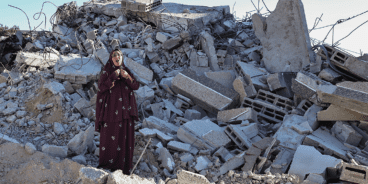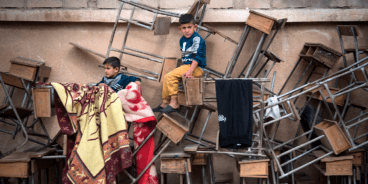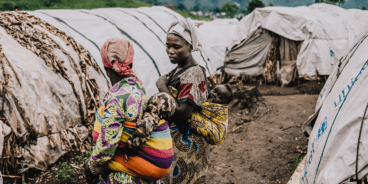
The 2nd Annual Gareth Evans Lecture: Operationalizing the Responsibility to Protect
The following is an abridged version of the speech delivered by Lieutenant-General The Honourable Romeo A. Dallaire at the Second Annual Gareth Evans Lecture, held on 18 October 2012 at the Scandinavia House in New York.
Thank you ladies and gentlemen, and thank you Dr. Francis Deng for your introduction. Also, may I say “kudos” to a very good friend, Gareth Evans. I like the term “godfather of R2P” because it brings up, of course, the movie “The Godfather” and the power that individual had. I like to think that Gareth still holds a lot of power in moving R2P forward and so I’m very honored to be the lecturer in this institution established under his name. And, also, I would like to acknowledge Dr. Edward Luck who is here, and who I worked with on R2P for the UN. Thank you for also attending. I would lastly like to acknowledge all the ambassadors, including the Canadian ambassador. I hope whatever is said here might be useful and I hope that it will generate conversations and discussions subsequently.
I thought it essential to take a grand strategic perspective on the Responsibility to Protect and look at where it’s at and where it’s going. I’d prefer to do this rather than focus on some very local discussions, or even worry about whether or not it is moribund because it’s actually been tested over the last while and there are diverging views about how well this new doctrine for the international community is actually performing. I’m going to use the term doctrine because to me it is an instrument from which you can deduce so much.
In military parlance, the term doctrine is born out of one’s philosophy on war and peace; in other words, how you see peace being achieved through the extreme elements of war or the disciplined use of force. From that conceptual base you build a doctrine, which is describing it more narrowly in terms of the instruments that might be used to achieve your aims. From the doctrine — and this is where I believe we are at with R2P — you determine your organizations, your tactics, your training, your equipment, and the operationalization of that doctrine.
The question now is: do we have a problem with the conceptual base of R2P, do we have a problem with the operationalization of R2P, or do we really have a problem? Are we at a point where we’re trying to figure out how to have it as part of our arsenal for not just advancing conflict resolution, but also for the ultimate aim of conflict prevention? That is a lot harder to achieve. It’s a bigger risk politically and requires in-depth longterm commitments from the international community. So I’m going to work our way through that, if I may, while also articulating certain reforms, and I think the term reform here is not too strong. We’re possibly already beyond reform.
I would argue we’re maybe in an era of revolution in that we’re trying to figure out how this new era is actually going to evolve positively from the old era, the classic era, the one that ended with the Cold War. In this new era, we are still stumbling in our effort to ensure that humanity will thrive and not just survive. That’s the grand strategic perspective.
If you’re starting from the premise that we should only hope that humanity survives, then you’re already in the wrong grid square. For in this time of communications revolution, the younger generation of the under twenty-fives have become a generation without borders. But as we look at this era that is more and more evolving without borders, we find that our political leadership is stuck on the nation state, on some of the fundamental elements of political survival, which is essentially pragmatism, tactical thinking and very short term in nature — tomorrow morning’s New York Times. Because we’re caught up in this risk-averse environment, it is difficult to move forward revolutionary thinking that will lead us into wanting to take risks to advance situations. So what we are screaming for — and I don’t exaggerate that statement — is statesmanship.
In my opinion, we are in an era where we’ve got to start from the premise that we want humanity to thrive and that we are not looking just at how it will survive. For example, think about how the environmental revolution promotes the communion between humanity and the planet.
The next question that I consider quite fundamental in the exercise is “are all humans human?” In fact, do we all count the same? Are we really all equal human beings or are some more equal than others? I believe this question is essential if you believe in the fundamental premises of the three pillars of R2P, and certainly the first two in particular, and in the prevention of conflict through the advancement of humanity. Is it worth considering that every human being can possibly be equal and that their value as a human being is equal?
During the genocide in Rwanda, extremists would use young children to stop UN convoys. If they didn’t stay there, they’d kill them. The convoys would have to stop because the kids would be in the middle of the road and then they’d attack the convoy and steal the water, food, medical supplies and so on. So on one occasion, as I’m going through no-man’s-land, there was a little boy about seven years-old who was a couple of hundred meters ahead. Expecting that this might be an ambush, I stopped, got a couple of soldiers with me, jumped out, but there was no ambush. We went into the huts along the road where people had been killed weeks earlier, but then we realized that we had lost the child.
As we doubled back we found him in a hut with two adults, male and female, and a couple of children half eaten by dogs and rats. He was sitting there as if he was at home. I picked him up and I brought him to the front of my vehicle and I looked at him. He was in rags, he was dirty, he was mangy, his stomach was bloated, and there were flies all around him. But then I looked into his eyes and what I saw in the eyes of that little seven year-old boy caught up in that civil war and that genocide was exactly what I saw in the eyes of my seven year-old son when I left Quebec City for Africa. They were the eyes of a human child and they were exactly the same. They were equal.
That kid in that catastrophe was just as human and counts just as much as my son back home — and I know what my son is going through in trying to grow up in our demanding society. But what happened to that kid in Rwanda? What happened to the millions of them? You see, we have, through our actions and inactions, actually set a pecking order for humanity, and I would argue right now that, through those actions and inactions over the last twenty-odd years, we’ve put the Sub-Saharan black African lowest on the totem pole. In so doing, are we actually ethical given our belief in human rights and our inclusion of them in some of the fundamental laws of some of our nations? Or do we simply believe that human rights count for us and those who can afford a lawyer and for the others, well, we hope it can work out?
The Rwandan genocide is only one example of not only what has happened, but of course what has the possibility and potential to happen again. It is not linked purely to one continent. On the contrary, several continents have countries that can implode and ultimately self-destruct and fall into mass human destruction and ultimately even genocide.
The question is what happened to that concept called “never again?” Did “never again” actually work? If it did we wouldn’t have had Cambodia, we wouldn’t have had Rwanda, we wouldn’t have had Srebrenica. For about 400 years there has been this concept in the world where the Euro-centric Caucasian was an entity of humanity and every other human being was “the other.” But over the last decades, as we’ve seen far more transparency in international affairs along with advances in technology and education, the idea of “the other” doesn’t exist anymore because everybody is “the other” of everybody else.
Within the first week of the Rwandan genocide, every major power had come by my headquarters and sent reconnaissance people. I would say, “what is your report?” Their report would always be, “well Sir, we’re recommending we don’t come, that we don’t help you in this conflict.” I would say, “why not?” They would say, “there’s nothing here. It has no strategic resources of any value. It’s not even in a strategic location that would help us. The only thing that’s here are human beings. And there are too many of them anyways. It’s overpopulated.”
The fact that human beings were the element being destroyed did not create a willingness to consider intervention. I was just looking for reinforcement to try and stop a bit of the killing. I didn’t care if those two belligerents wanted to continue their civil war. What I cared about was stopping the slaughter behind the lines. Maybe that might have attenuated the civil war.
In any event, no one came. And it’s not because they didn’t see it – it got as much TV time as OJ Simpson got with his trial and Tonya Harding kneecapping her opposition, so it was seen. No one came because the human factor did not carry the day.
So how do you get away with the concept that human beings are the lowest denominator in your decision-making processes? That you won’t take risks because of human beings, but you will take risks for other elements? I argue that the most interesting case that was playing out at the same time was ex-Yugoslavia, where there were less people killed, injured, internally displaced and raped than in Rwanda, yet we poured 67,000 troops into the country and I couldn’t keep 450 in Rwanda.
Indeed, somebody made some decisions. What were the parameters of those decisions? Do those parameters stand? Can we actually defend them and feel that we are being ethical with ourselves, with the institutions we’ve created and with the systems of governance with regards to human rights, democracy, gender equality and the rule of law? The question is: is it all about self-interest or can we create in our political structures a will to intervene?
And so ladies and gentlemen, in this incredible era of ambiguity, anxiety and complexity, it’s natural for any new revolutionary tool that may emerge to undergo an apprenticeship. But I believe that this era and the tools that have emerged, such as R2P and the “will to intervene,” are going to start to change the scenario. We need a whole new set of tools for our era.
In this new era that we stumbled into, the UN Charter’s Chapter VI exercises—the Blue Beret with the short pants, the baseball hat and no red card—are over. We are at a minimum looking at Chapter VII, and I would argue that we should have been using Chapter VIII in many circumstances. Darfur is a perfect example of where we could have. The question is, are we learning or are we repeating the mistakes of the past?
When Boutros-Ghali ordered me out of Rwanda in the third week of the genocide, the argument that he used on the phone was, that the international community could not handle 450 more blue berets being killed. The fact that they were slaughtering 10,000 human beings a day did not weigh into the exercise. And so I refused that order. It was a legal order, and I refused it. It wasn’t because I thought it out, it was instinctive. He repeated it, and I responded again, maybe because I was stubborn, the second time. So he hung up and rang up the phone a third time and I refused it again.
I refused a legal order to pull out my troops in order to protect them. If I had pulled them out, we would have permitted about 30,000 Rwandans that we had under our protection to be slaughtered. One country had pulled out their troops too fast without orders and 4,000 people were slaughtered in hours. So the order was legal, but it was immoral.
This is but a small part of the exercise that is ongoing. As we try to work our way through these conflicts and resolve them, we should have spent far more time and effort learning how to prevent them in the first place.
Our options are relatively clear. Inaction, ladies and gentlemen, has been the case far too often and inaction is the course that too many political leaders like to take. Inaction is a decision and an abdication of our responsibility to prevent mass atrocities from happening. Inaction is a sin against humanity.
However, there are now new tools that are not going to permit inaction so easily. The media is certainly out there and it’s going to keep the people nervous and worried. The other one, which I devote a lot of time towards, is civil society. In fact, I would argue that the NGOs — the eyes and ears of humanity — already significantly sway future policy and public opinion. They cover every element and spectrum of humanity. There may be that occasional wacko on the fringe, but by and large they are fundamentally focused. They are there before, during and after a crisis. So I say: join the NGO community. Go get your boots dirty with that eighty percent of humanity out there.
But of those three phases of conflict, ladies and gentlemen, the hardest one is prevention. Reaction may cost bodies, reconstruction costs money, but prevention costs political capital. That’s where the real heart of a solution exists. We’ve tried to articulate that those engaged in decision-making need new tools to be able to advance into the future. In so doing they’ve got to change their perspective on political will and what their self-interest is and their fear of casualties.
Mogadishu created the fear of casualties and changed the foreign policy of the United States. Bill Clinton turned tail after Mogadishu and six months later, with Presidential Directive TwentyFive, articulated that the United States would not engage in any activity unless it’s in its self-interest. So they didn’t come to Rwanda and they didn’t help anybody else who wanted to come.
And so, the will to intervene, to me, is the solution. It’s about leadership. It needs to be part of the operationalizing of the Responsibility to Protect in the extremis. Not just intervening militarily, but intervening in the more positive sense during prevention mode.
I’m going to end by saying that middle power countries have got to be far more engaged. We’re leaving too much to the big powers. The middle powers have got to coalesce and they have got to be offering other options rather than simply what the big powers are stumbling through with.
Developing countries are looking to us to provide innovative approaches to solving global problems. We can achieve that by using some of the more progressive tools that are starting to appear. One of the most fundamental tools is the Responsibility to Protect, which is essentially our desire to prevent conflict from going catastrophic. And, if conflicts do go catastrophic, we need to have the courage and determination to intervene early and prevent them from getting worse.
Thank you.
Related Content


